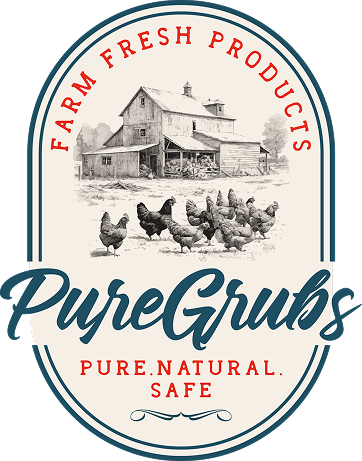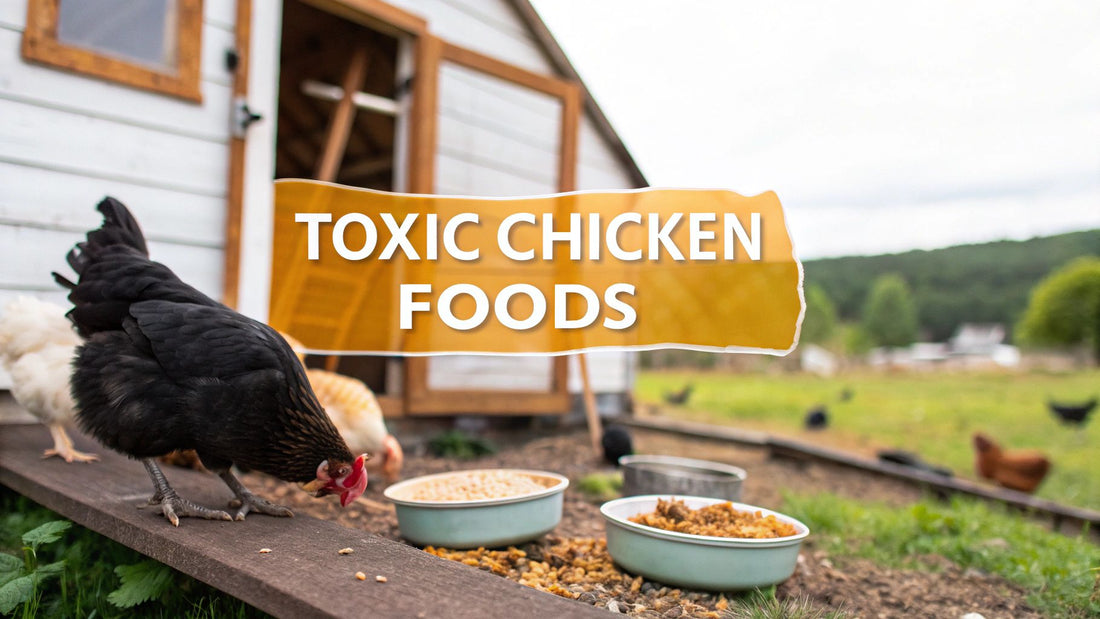
8 Foods Harmful to Chickens You Must Avoid in 2025
Share
Keeping a happy, healthy flock involves more than just providing standard feed and fresh water. While sharing kitchen scraps can be a wonderful way to bond with your chickens and reduce waste, not all human foods are safe for them. Certain common items, from fruits to leftovers, can cause serious illness or even prove fatal. This guide provides an essential, detailed look into the most critical foods harmful to chickens, ensuring you have the knowledge to protect your birds.
Understanding what to avoid is about safeguarding your flock’s long-term health, ensuring optimal egg production, and preventing veterinary emergencies. Many well-intentioned owners unknowingly offer treats that contain hidden toxins or compounds that a chicken's digestive system simply cannot process. The consequences can range from mild digestive upset to severe neurological damage or sudden death.
In this comprehensive list, we will break down exactly which foods pose a significant threat. For each item, you will learn:
- The specific toxic compound responsible for the danger.
- The symptoms of poisoning to watch for in your flock.
- Practical tips for preventing accidental exposure.
- Safe, nutritious alternatives to offer instead.
Our goal is to equip you with clear, actionable information so you can confidently decide what goes into your flock's diet. By learning about the most common foods harmful to chickens, you can ensure your kitchen scraps are a source of enrichment and nutrition, not a potential hazard. Let's explore the specific items you must keep away from your coop.
1. Avocado
Avocado, a popular and nutritious food for humans, is unfortunately one of the most dangerous foods harmful to chickens. The entire avocado plant, including the fruit's flesh, pit, skin, and even the leaves and bark of the tree, contains a fungicidal toxin known as persin. While generally harmless to people, persin is highly toxic to birds, including chickens.
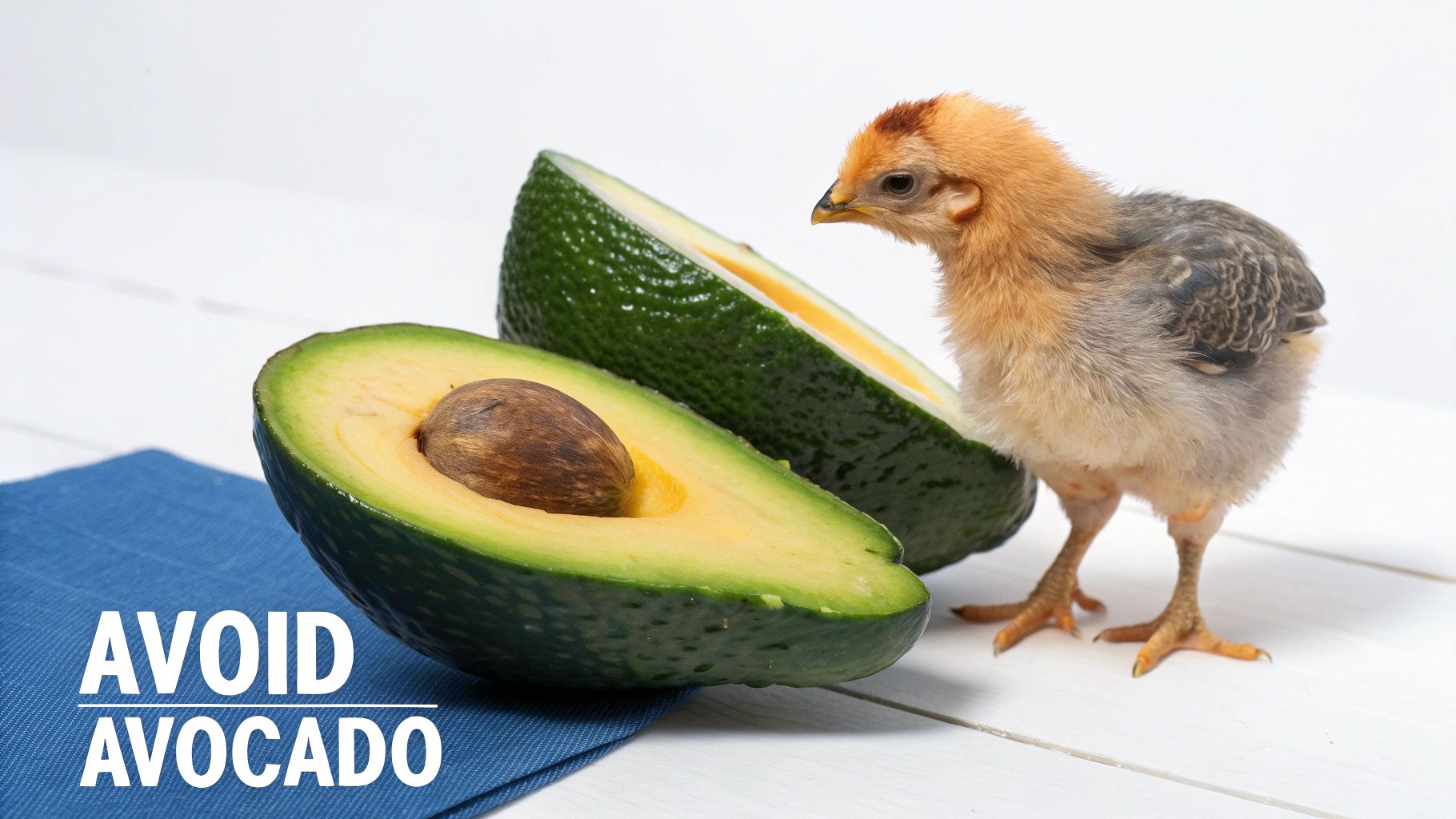
The concentration of persin is highest in the pit and skin, but the flesh also contains enough to cause severe health issues. Ingesting even a small amount can lead to a condition known as persin toxicosis.
Why Avocado is Dangerous for Chickens
The primary danger lies in persin's effect on the avian cardiovascular system. When a chicken consumes avocado, the toxin can cause:
- Myocardial Necrosis: This is the death of heart muscle tissue, leading to an inability of the heart to pump blood effectively.
- Respiratory Distress: Fluid can accumulate in the lungs and body cavities (a condition called hydropericardium), making it difficult for the chicken to breathe. Symptoms often appear within 12 to 24 hours of ingestion.
- Sudden Death: In many cases, especially with high doses of persin, chickens can die suddenly without showing many prior symptoms.
Actionable Tips for Prevention
Given the severity of the risk, complete avoidance is the only safe approach.
- Secure Compost Bins: Never toss avocado pits, skins, or leftover guacamole into a compost pile that your flock can access. Chickens are notorious for scratching through compost for tasty scraps.
- Educate Family and Neighbors: Ensure everyone who might feed your chickens is aware of the danger. A well-meaning neighbor could unknowingly cause harm by tossing their kitchen scraps over the fence.
- Garden and Orchard Awareness: If you live in a climate where avocado trees grow, ensure your flock's roaming area is securely fenced off from them. Chickens will readily eat fallen leaves and fruit.
Key Takeaway: There is no "safe" part of the avocado for chickens. The risk of heart failure and respiratory distress is too high to ever justify it as a treat.
Instead of risky human foods, stick to treats that are specifically beneficial for your flock's health. You can explore a variety of safe and nutritious options to keep your chickens happy. To get ideas for better treat choices, you can find a list of healthy snacks for chickens that support their well-being.
2. Chocolate and Caffeine
Chocolate and other caffeinated products, while enjoyable treats for humans, are highly toxic and should be considered foods harmful to chickens. These items contain methylxanthines, specifically theobromine and caffeine, which are stimulants. Birds, including chickens, metabolize these compounds much more slowly than humans, allowing them to build up to toxic levels in their system.
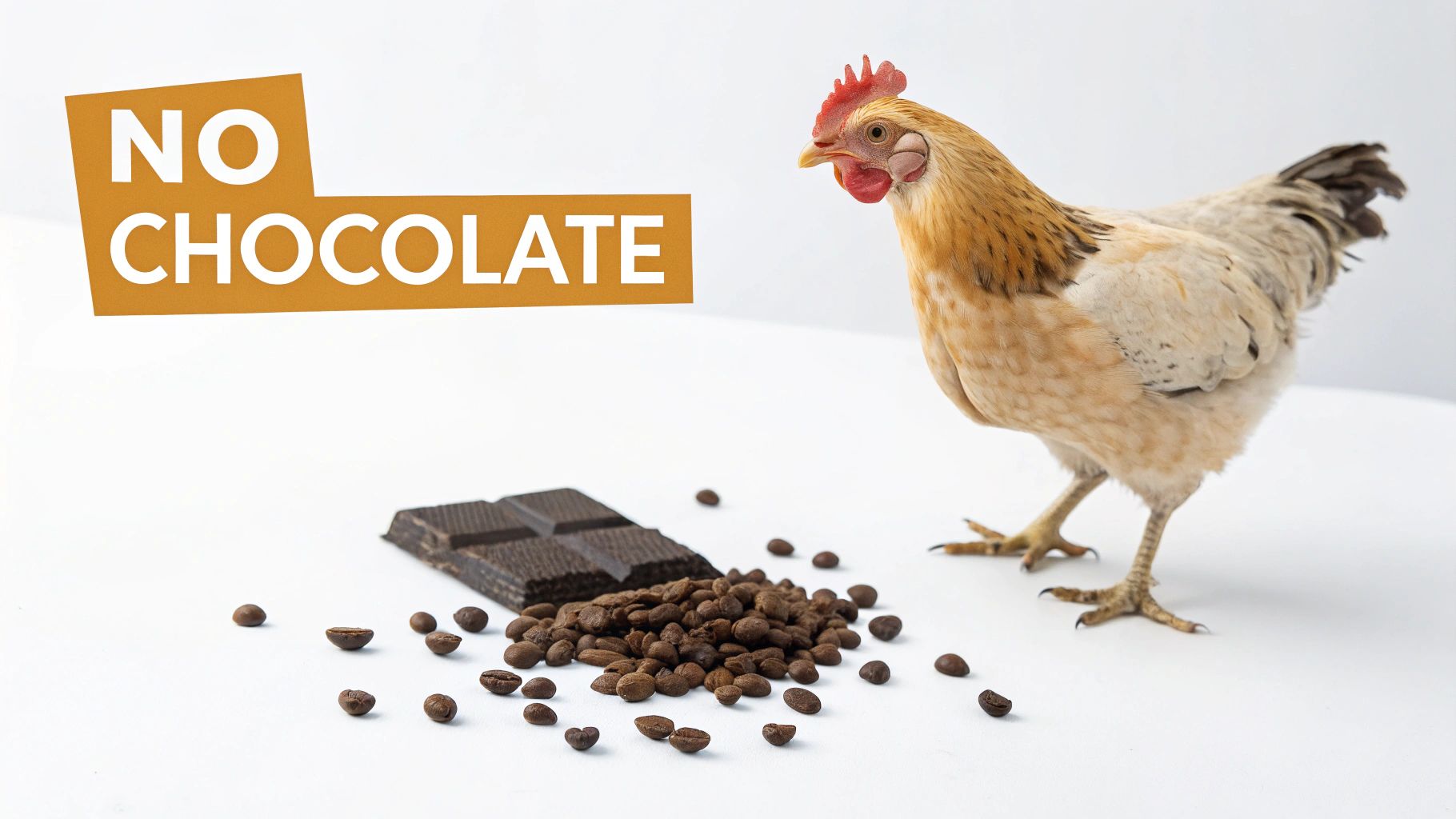
The level of toxicity varies depending on the type of chocolate, with dark chocolate and baker’s chocolate containing the highest concentrations of theobromine. However, even milk chocolate, coffee grounds, tea bags, and soda can contain enough of these stimulants to cause serious harm to a chicken.
Why Chocolate and Caffeine are Dangerous for Chickens
The methylxanthines in these products directly impact a chicken’s central nervous and cardiovascular systems. When a chicken ingests chocolate or caffeine, the toxins can trigger a range of severe physiological reactions:
- Cardiac Issues: The stimulants can cause an increased heart rate (tachycardia), irregular heartbeat (arrhythmia), and high blood pressure, potentially leading to cardiac arrest.
- Neurological Problems: Symptoms include hyperactivity, restlessness, muscle tremors, and seizures. The chicken may appear agitated or disoriented.
- Gastrointestinal Distress: Vomiting and diarrhea are common initial signs as the chicken's body tries to expel the toxins.
Actionable Tips for Prevention
Because chickens are often curious foragers, preventing accidental ingestion is crucial.
- No Kitchen Scraps with Chocolate: Never give chickens leftover desserts like cake, cookies, or brownies. Be mindful of less obvious sources, such as mole sauce or certain breakfast cereals.
- Secure Trash and Compost: Keep household garbage bins tightly sealed. Do not throw coffee grounds, tea bags, or any chocolate wrappers into an open compost pile that your flock can access.
- Supervise Outdoor Events: During backyard parties or picnics where chocolate desserts or caffeinated drinks might be present, ensure your flock is securely cooped up to prevent them from eating dropped food or spilled beverages.
Key Takeaway: All forms of chocolate and caffeine are toxic to chickens. The risk of severe cardiac and neurological damage means these items should never be offered, not even in the smallest amounts.
Instead of sharing potentially dangerous treats, opt for safe, protein-rich snacks that support your flock’s health. You can discover a range of healthy treat options for your chickens that are both delicious and beneficial for them.
3. Moldy or Spoiled Food
While it can be tempting to view chickens as living garbage disposals for kitchen scraps, feeding them moldy or spoiled food is a significant health risk. Food that is past its prime for human consumption is also unsuitable for chickens and can introduce dangerous pathogens and toxins into their system, making it one of the most deceptively common foods harmful to chickens.
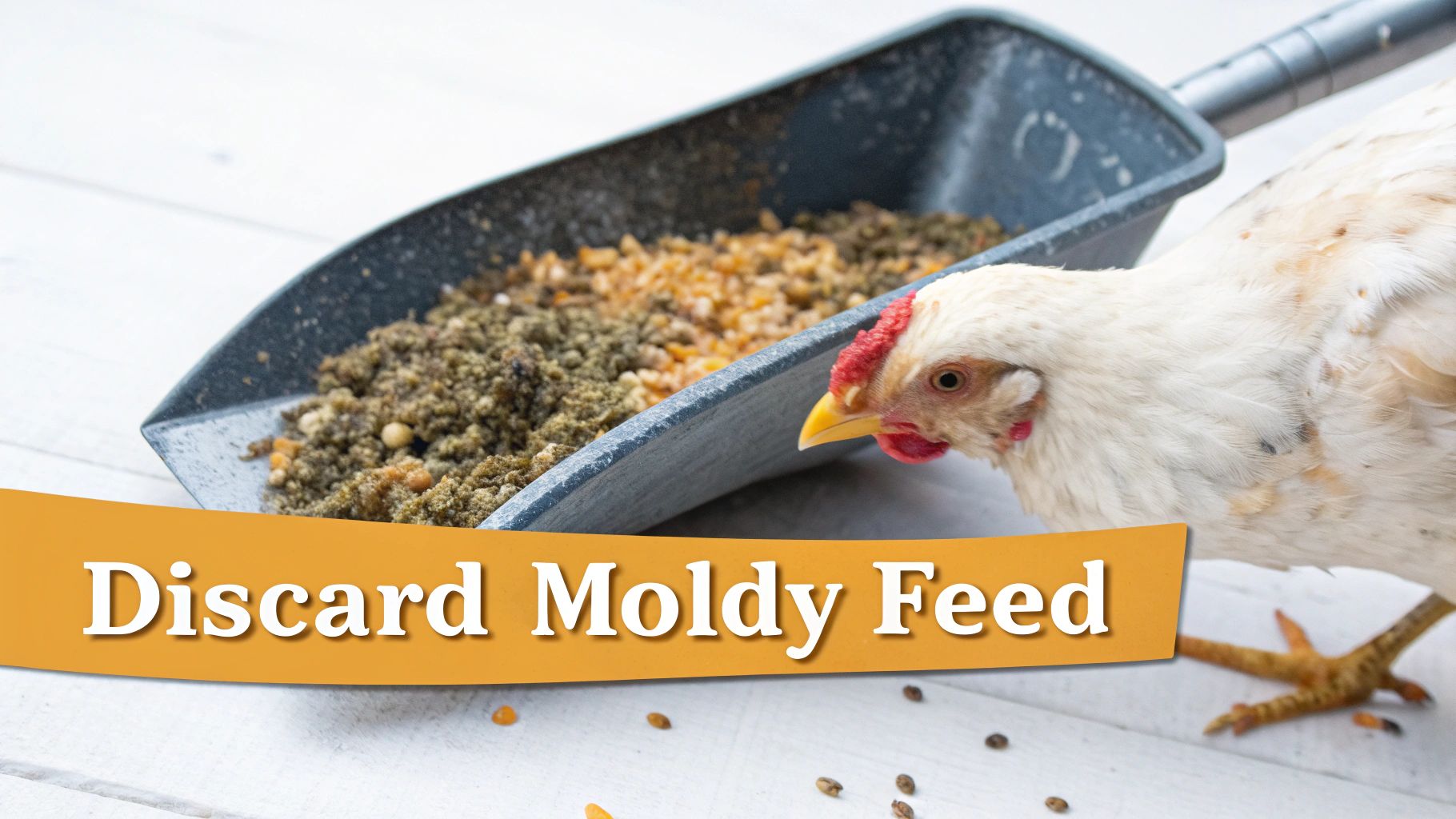
The visible mold on spoiled bread, fruit, or old feed is just the surface-level sign of a deeper problem. These fungi produce mycotoxins, which are poisonous compounds that can cause severe and sometimes irreversible damage to a chicken's health.
Why Moldy or Spoiled Food is Dangerous for Chickens
The primary dangers stem from mycotoxins and pathogenic bacteria that thrive in decaying organic matter. Ingesting these substances can lead to several serious conditions:
- Mycotoxicosis: This is poisoning from mycotoxins. These toxins can cause liver damage (aflatoxicosis), suppress the immune system, reduce egg production, and lead to neurological issues. Chickens may appear lethargic, lose their appetite, and have ruffled feathers.
- Bacterial Infections: Spoiled food is a breeding ground for harmful bacteria like Salmonella, E. coli, and Clostridium botulinum (which causes botulism). These can lead to severe gastrointestinal distress, diarrhea, and potentially death.
- Aspergillosis: This is a respiratory disease caused by inhaling mold spores, often from moldy feed or damp bedding. It results in gasping, weakness, and can be fatal, especially in young chicks.
Actionable Tips for Prevention
Safe food storage and handling are critical to protecting your flock from the dangers of spoilage.
- Inspect All Feed: Store chicken feed in a dry, cool place in a sealed, rodent-proof container. Before feeding, always check for clumps, a musty smell, or visible signs of mold.
- Follow the "If You Wouldn't Eat It" Rule: When giving kitchen scraps, a good guideline is to only offer food that is still fresh enough for human consumption. Wilted lettuce is fine; moldy bread is not.
- Maintain Cleanliness: Keep feeders and waterers clean to prevent bacterial growth and mold. Promptly remove any wet or soiled feed from the coop and run.
Key Takeaway: Never assume a chicken's digestive system can handle spoiled food. The invisible mycotoxins and bacteria present a severe risk of organ damage, respiratory illness, and fatal infections.
Properly identifying and managing digestive issues is crucial if your flock is exposed to bad food. You can discover how to handle poultry digestive problems to ensure a swift recovery.
4. Raw or Dried Beans (Uncooked Legumes)
While cooked beans can be a nutritious, protein-packed treat for chickens, their raw or dried counterparts are extremely dangerous. Uncooked beans, including kidney, lima, and navy beans, contain a toxic lectin called phytohaemagglutinin. This natural compound is a defense mechanism for the plant, but it is highly poisonous to chickens and other animals, including humans.
This toxin is not destroyed by simply soaking the beans; it must be denatured with high heat. Feeding even a few raw or improperly cooked beans to a chicken can lead to severe illness and is often fatal. The toxin acts quickly, with symptoms appearing in as little as an hour after ingestion.
Why Raw or Dried Beans are Dangerous for Chickens
Phytohaemagglutinin is a hemagglutinin, meaning it causes red blood cells to clump together. When ingested by chickens, this toxin can cause:
- Severe Gastrointestinal Distress: The toxin aggressively attacks the lining of the digestive tract, causing nausea, vomiting, and severe diarrhea.
- Malabsorption: It damages the intestinal villi, preventing the chicken from absorbing any nutrients from its food.
- Rapid Onset of Illness: The effects are swift and can be deadly within a few hours. A healthy chicken can become critically ill very quickly.
Actionable Tips for Prevention
The key to safely feeding beans is proper preparation. If you choose to offer them, you must neutralize the phytohaemagglutinin completely.
- Boil Vigorously: Never use a slow cooker, as the lower temperatures can actually increase the toxicity. Dried beans must be boiled at a rolling boil (212°F or 100°C) for a minimum of 30 minutes. Ten minutes is often cited, but a longer boil ensures complete neutralization.
- Cool Completely Before Serving: After boiling, drain the beans and let them cool down to room temperature before offering them to your flock.
- Feed as a Treat: Cooked beans should only be given in moderation as part of a balanced diet, not as a primary food source.
- Secure Storage: Keep all packages of raw, dried beans securely stored away from any area your chickens can access. A torn bag in a pantry or feed shed can lead to disaster.
Key Takeaway: Raw and improperly cooked dried beans are acutely toxic to chickens. Only beans that have been boiled vigorously for at least 30 minutes are safe to feed, and only as an occasional treat.
When looking for safe, protein-rich treats, it's often better to stick with options specifically meant for poultry. For a reliable and healthy alternative, you can explore the benefits of high-protein grubs for chickens that don't carry the risks associated with improper preparation.
5. Salt and High-Sodium Foods
While a small amount of salt (sodium chloride) is a necessary component of a chicken's diet for bodily functions, an excess can quickly become toxic. Many common human foods and snacks are loaded with sodium, making them dangerous and potentially fatal foods harmful to chickens. Unlike humans, chickens do not have sweat glands to excrete excess salt and their kidneys are not equipped to handle high concentrations, leading to severe health complications.
Giving chickens leftover potato chips, pretzels, or heavily salted table scraps can quickly lead to salt poisoning, also known as sodium ion toxicosis. This condition disrupts their delicate electrolyte balance and can cause irreversible organ damage.
Why Salt and High-Sodium Foods are Dangerous for Chickens
The primary danger of excess sodium is its effect on a chicken's hydration and internal organ function. When a chicken consumes too much salt, the body pulls water from its cells to dilute the sodium in the bloodstream, resulting in:
- Severe Dehydration: Chickens will become excessively thirsty, but often cannot drink enough water to counteract the salt's effects, leading to cellular dehydration.
- Kidney Damage: The kidneys become overworked trying to filter out the high levels of sodium, which can lead to kidney failure.
- Neurological Issues: Salt poisoning can cause fluid accumulation in the brain and nervous system, leading to symptoms like loss of coordination, staggering, and convulsions.
- Hypertension and Heart Failure: High sodium intake can increase blood pressure, putting a strain on the cardiovascular system and potentially leading to heart failure.
Actionable Tips for Prevention
Preventing salt poisoning requires careful management of what your flock eats beyond their formulated feed.
- Avoid Processed Foods: Never feed chickens salty snacks like chips, crackers, pretzels, or processed meats such as bacon, ham, and salami. These foods contain far more sodium than a chicken can safely handle.
- Be Cautious with Kitchen Scraps: Many cooked human foods, even seemingly healthy ones, are prepared with added salt. If you share leftovers, ensure they are unsalted or very lightly seasoned.
- Provide Constant Fresh Water: Always ensure your flock has unlimited access to fresh, clean water. This is their primary way to flush excess salt from their system and is crucial for preventing dehydration.
- Check Commercial Feed Labels: Stick to a high-quality, balanced commercial feed formulated for your chickens' specific life stage. These feeds contain the correct, safe amount of sodium required for their health.
Key Takeaway: A chicken's system is not designed to process high levels of sodium. What seems like a harmless salty treat to a human can lead to severe dehydration, organ failure, and death in a chicken.
Instead of offering salty leftovers, choose healthy, natural treats that are safe for your flock. For more ideas on beneficial snacks, you can explore this guide to chicken-safe foods to ensure you are supporting their well-being.
6. Green Potatoes and Solanine-Containing Foods
While cooked potatoes can be an occasional starchy treat for chickens, green potatoes are firmly on the list of foods harmful to chickens. Potatoes, along with other members of the nightshade family like tomatoes and eggplants, produce a glycoalkaloid toxin called solanine. This natural pesticide is concentrated in the green parts of the plant, including leaves, stems, and any part of the potato tuber that has been exposed to light and turned green.
Solanine is also highly concentrated in the "eyes" or sprouts of a potato. As a potato ages and begins to sprout, the solanine levels increase dramatically, making these parts particularly dangerous for your flock.
Why Green Potatoes are Dangerous for Chickens
Solanine is a neurotoxin that can also cause severe gastrointestinal distress. When chickens ingest it, the toxin interferes with nerve impulses and can lead to a range of serious symptoms, including:
- Gastrointestinal Issues: Chickens may experience diarrhea, loss of appetite, and general digestive upset.
- Neurological Symptoms: The most concerning effects are neurological. You might observe lethargy, paralysis, stumbling, or convulsions as the toxin impacts the central nervous system.
- Respiratory Failure: In severe cases of solanine poisoning, the toxin can lead to respiratory distress and, ultimately, death.
Actionable Tips for Prevention
You can safely feed your chickens potatoes, but only with careful preparation and by avoiding the dangerous parts of the plant.
- Avoid All Green Parts: Never feed your chickens potato peels that have any green on them, nor should they have access to the potato plants themselves (leaves, stems, or flowers).
- Proper Preparation is Key: If you offer potatoes as a treat, they must be cooked. Thoroughly boil mature, non-green potatoes until soft. Never feed them raw.
- Inspect and Remove Sprouts: Before cooking, meticulously inspect potatoes and cut away any sprouts or "eyes," along with a generous portion of the surrounding flesh, as this is where solanine is most concentrated.
- Store Potatoes Properly: Keep your potatoes in a cool, dark, and dry place to prevent them from turning green or sprouting, thus minimizing solanine production.
Key Takeaway: Unripe, green, or sprouted parts of nightshade plants contain toxic levels of solanine. Cooked, ripe potatoes are safe in moderation, but the green parts and raw spuds pose a significant risk of poisoning.
7. Pesticides and Chemical Contaminants
While not a "food" in the traditional sense, the chemicals present on food items are a significant and often invisible danger to your flock. Pesticides, herbicides, and other agricultural chemicals sprayed on fruits, vegetables, and grains can accumulate in a chicken's body, leading to chronic health issues. These contaminants are some of the most insidious foods harmful to chickens because they are not always obvious.
Chickens are particularly susceptible because they forage constantly, potentially consuming treated lawn clippings, commercially grown produce scraps, or grains that have been treated for pests. Even small, repeated exposures can build up over time and cause serious harm.
Why Pesticides and Chemicals are Dangerous for Chickens
The danger lies in the cumulative and systemic impact these toxins have on a chicken's body. Unlike an immediate poison, the damage is often slow and progressive.
- Organ Damage: Chemicals can accumulate in fatty tissues and vital organs like the liver and kidneys, leading to long-term damage and eventual organ failure.
- Compromised Immunity: Exposure to these toxins can suppress the chicken's immune system, making the entire flock more vulnerable to common diseases and infections.
- Endocrine Disruption: Many pesticides interfere with the endocrine system, which can disrupt a hen's reproductive cycle, leading to decreased egg production, thin-shelled eggs, or complete cessation of laying.
- Neurological Issues: Some chemical agents can affect the nervous system, causing tremors, lack of coordination, paralysis, or other neurological symptoms in severe cases.
Actionable Tips for Prevention
Protecting your flock from chemical contaminants requires diligence in sourcing their food and managing their environment.
- Wash All Produce: Thoroughly wash any fruits and vegetables from the grocery store before offering them as treats. This helps remove surface-level residues.
- Choose Organic: Whenever possible, feed your chickens organic scraps and grains. Organic produce is grown without the use of synthetic pesticides and herbicides.
- Maintain a Chemical-Free Yard: Avoid using chemical pesticides, herbicides (like weed killers), or fertilizers on any lawn or garden area your chickens can access. Opt for natural, poultry-safe pest and weed control methods instead.
- Vet Your Feed Source: Purchase feed from reputable suppliers who test their products for contaminants. Low-quality or improperly stored feed can be a source of chemical exposure.
Key Takeaway: The unseen threat of chemical contaminants can cause gradual but severe health problems. Prioritizing clean, organic food sources and maintaining a chemical-free environment is crucial for your flock's long-term health.
Instead of feeding your chickens conventional produce scraps that may be contaminated, consider supplementing their diet with safe, high-quality protein sources. To learn about a nutritious and clean treat option, you can discover the benefits of black soldier fly larvae for your flock.
8. Mycotoxin-Contaminated Corn and Grain
While corn and other grains are staple components of commercial chicken feed, they can become one of the most insidious foods harmful to chickens when contaminated with mycotoxins. These toxins are produced by certain types of mold that grow on grains, particularly corn, wheat, and peanuts, often in warm and humid storage conditions. The most common and dangerous mycotoxins for poultry are aflatoxins and fumonisins.
The danger lies in their subtlety. Contaminated feed may not look or smell obviously moldy, yet it can contain levels of toxins high enough to cause severe, chronic health problems. Chickens are highly susceptible to these toxins, which can accumulate in their system over time.
Why Contaminated Grain is Dangerous for Chickens
Mycotoxins act as potent poisons, systemically damaging a chicken's internal organs and immune function. Even at low levels, long-term exposure can be devastating.
- Severe Liver Damage: Aflatoxin is a powerful hepatotoxin, meaning it specifically targets and destroys liver cells. This can lead to liver failure, a condition known as aflatoxicosis.
- Immunosuppression: Mycotoxins weaken the chicken's immune system, making the entire flock more vulnerable to common diseases like Coccidiosis and Marek's disease.
- Reduced Growth and Egg Production: Poisoning can lead to poor feed conversion, stunted growth in young birds, and a significant, often inexplicable, drop in egg-laying. Neurological symptoms like poor coordination can also occur.
- Increased Mortality: In acute cases or with high levels of contamination, mycotoxin poisoning can lead to unexplained deaths within the flock.
Actionable Tips for Prevention
Preventing mycotoxin exposure is all about proper feed selection and storage.
- Purchase from Reputable Sources: Always buy feed from trusted suppliers who have quality control measures to test for mycotoxins. Avoid feed that looks clumped, discolored, or smells musty.
- Practice Proper Storage: Store all feed in a cool, dry, and well-ventilated area. Use sealed, rodent-proof containers to protect it from moisture and pests. Never store feed bags directly on a concrete floor where they can absorb moisture.
- Use Feed Promptly: Buy only enough feed that you can use within a few weeks. The "first in, first out" rule is critical; always use your oldest feed stock first before opening a new bag.
Key Takeaway: The unseen threat of mycotoxins in improperly stored grain is a serious risk. Prioritizing fresh, high-quality feed and impeccable storage hygiene is essential for protecting your flock from liver damage and immune suppression.
Instead of taking a risk with suspect grain, focus on providing your flock with safe, high-quality nutrition. For reliable treat options that are guaranteed to be safe and beneficial, you might learn about the benefits of black soldier fly larvae as a healthy supplement.
Risk Comparison of 8 Foods Harmful to Chickens
| Item | Risk Severity ⭐ | Mitigation Complexity 🔄 | Resources & Speed ⚡ | Expected Health Impact 📊 | Immediate Action & Key Tip 💡 |
|---|---|---|---|---|---|
| Avocado | ⭐⭐⭐⭐⭐ Very high — cardiac & GI toxin | 🔄 Low — avoidance/removal | ⚡⚡ Fast to implement; minimal tools | 📊 Acute myocardium damage, digestive inflammation, sudden death | 💡 Remove all avocado parts, relocate trees, vet immediately if ingested |
| Chocolate and Caffeine | ⭐⭐⭐⭐ High — CNS & cardiac stimulants | 🔄 Low — secure/ban items | ⚡⚡ Fast; simple storage changes | 📊 Hyperactivity, tremors, arrhythmia, seizures | 💡 Prohibit chocolate/coffee grounds, secure scraps, quiet monitoring and vet care |
| Moldy or Spoiled Food | ⭐⭐⭐⭐⭐ Very high — mycotoxins | 🔄 Medium — storage & inspection routines | ⚡⚡⚡ Requires ongoing monitoring & storage changes | 📊 Liver damage, immune suppression, reproductive failure | 💡 Discard suspect feed, clean containers, improve ventilation/storage, monitor flock |
| Raw or Dried Beans (Uncooked) | ⭐⭐⭐⭐ High — lectin toxicity | 🔄 Low — proper cooking required | ⚡⚡ Moderate (cook time); simple equipment | 📊 Severe GI inflammation, dehydration, possible death | 💡 Never feed raw/dried beans; boil ≥160°F (70°C) ≥10 min, cool before offering |
| Salt and High-Sodium Foods | ⭐⭐⭐⭐⭐ Very high — rapid dehydration/kidney injury | 🔄 Low — remove salty items; monitor water | ⚡⚡⚡ Immediate action needed; provide water | 📊 Dehydration, electrolyte imbalance, tremors, collapse | 💡 Remove salty foods, unlimited fresh water, offer electrolytes and vet support |
| Green Potatoes & Solanine | ⭐⭐⭐⭐ High — neurotoxin | 🔄 Low — discard green/sprouted tubers | ⚡⚡ Quick to remove but inspect carefully | 📊 Neuro signs, GI upset, weakness, possible paralysis | 💡 Discard green/sprouted potatoes, trim thoroughly, vet for neurological symptoms |
| Pesticides & Chemical Contaminants | ⭐⭐⭐⭐⭐ Very high — chronic and acute toxicity | 🔄 High — testing, sourcing, environment control | ⚡⚡⚡⚡ Resource-intensive; long-term fixes | 📊 Nervous system disruption, organ damage, reproductive effects | 💡 Source pesticide-free feed, test water, eliminate exposure, consult vet and labs |
| Mycotoxin-Contaminated Corn & Grain | ⭐⭐⭐⭐⭐ Very high — aflatoxins/fumonisins | 🔄 Medium–High — testing & storage protocols | ⚡⚡⚡ Requires testing and improved storage | 📊 Hepatotoxicity, immune suppression, poor production, sudden death | 💡 Stop feeding suspect grain, test supplies, source certified clean grain, consider binders and supportive care |
Building a Safe and Nutritious Diet for Your Flock
Navigating the world of chicken nutrition can feel complex, but understanding the core principles of what to avoid is the most critical first step. This guide has detailed some of the most common and dangerous foods harmful to chickens, from the solanine in green potatoes to the persin in avocados and the toxins lurking in uncooked beans. By internalizing this list, you are building a vital shield that protects your flock from accidental poisoning, digestive distress, and even death.
Remember, a chicken's natural foraging instinct doesn't always distinguish between safe and unsafe. They rely entirely on your judgment as their keeper. Turning away from risky kitchen scraps isn't about depriving your birds; it's about making a conscious choice to prioritize their long-term health and well-being.
From Avoidance to Proactive Nutrition
Simply avoiding the bad is only half the equation. The true path to a thriving flock lies in a proactive approach: building a diet that is not only safe but also enriching and nutritionally complete. The cornerstone of this strategy is a high-quality commercial feed formulated specifically for their life stage, whether they are starter chicks, growing pullets, or laying hens. This balanced feed should always constitute the vast majority of their diet, typically around 90%.
The remaining 10% is where you can add variety and enrichment through treats. This is where your knowledge becomes power. Instead of tossing potentially harmful leftovers into the coop, you can deliberately choose supplements that boost their health.
Key Takeaway: A successful feeding strategy is built on two pillars: first, the strict avoidance of all known toxic foods, and second, the thoughtful supplementation of a balanced commercial feed with safe, high-value treats.
Actionable Steps for a Safer Feeding Routine
To translate this knowledge into daily practice, consider implementing a clear system for managing your flock's diet. This creates habits that minimize risk and maximize health benefits.
- Establish a "Safe Scraps" List: Keep a list on your refrigerator or near your compost bin of chicken-safe treats. This includes items like leafy greens (kale, spinach in moderation), cooked grains, berries, and melon. This visual reminder helps prevent family members from accidentally tossing harmful items into the coop.
- Create a Designated Treat Time: Instead of scattering scraps throughout the day, designate a specific time for treats, such as late afternoon. This helps you monitor intake, ensures every chicken gets a chance to partake, and prevents treats from spoiling in the run.
- Inspect All Food Sources: Before offering any food, give it a quick inspection. Is it moldy? Does it smell off? Was it prepared with excessive salt, sugar, or oil? This simple, two-second check can prevent a major health crisis.
- Educate Your Household: Ensure everyone who interacts with your chickens, including children and guests, understands the basic list of foods harmful to chickens. Explain that just because something is edible for humans doesn't make it safe for birds.
By mastering these concepts, you transition from being a passive provider to an active, informed flock manager. You're not just feeding chickens; you are cultivating a healthy, resilient, and productive ecosystem in your own backyard. The reward is not only in the fresh, delicious eggs they provide but also in the joy of watching a happy, energetic flock thrive under your care.
Ready to replace risky scraps with a treat you can trust? Pure Grubs offers 100% USA-grown Black Soldier Fly Larvae, providing a safe, high-protein, and calcium-rich supplement rigorously tested to be free from harmful contaminants. Elevate your flock's diet and give them a treat that supports their health by visiting Pure Grubs today.
